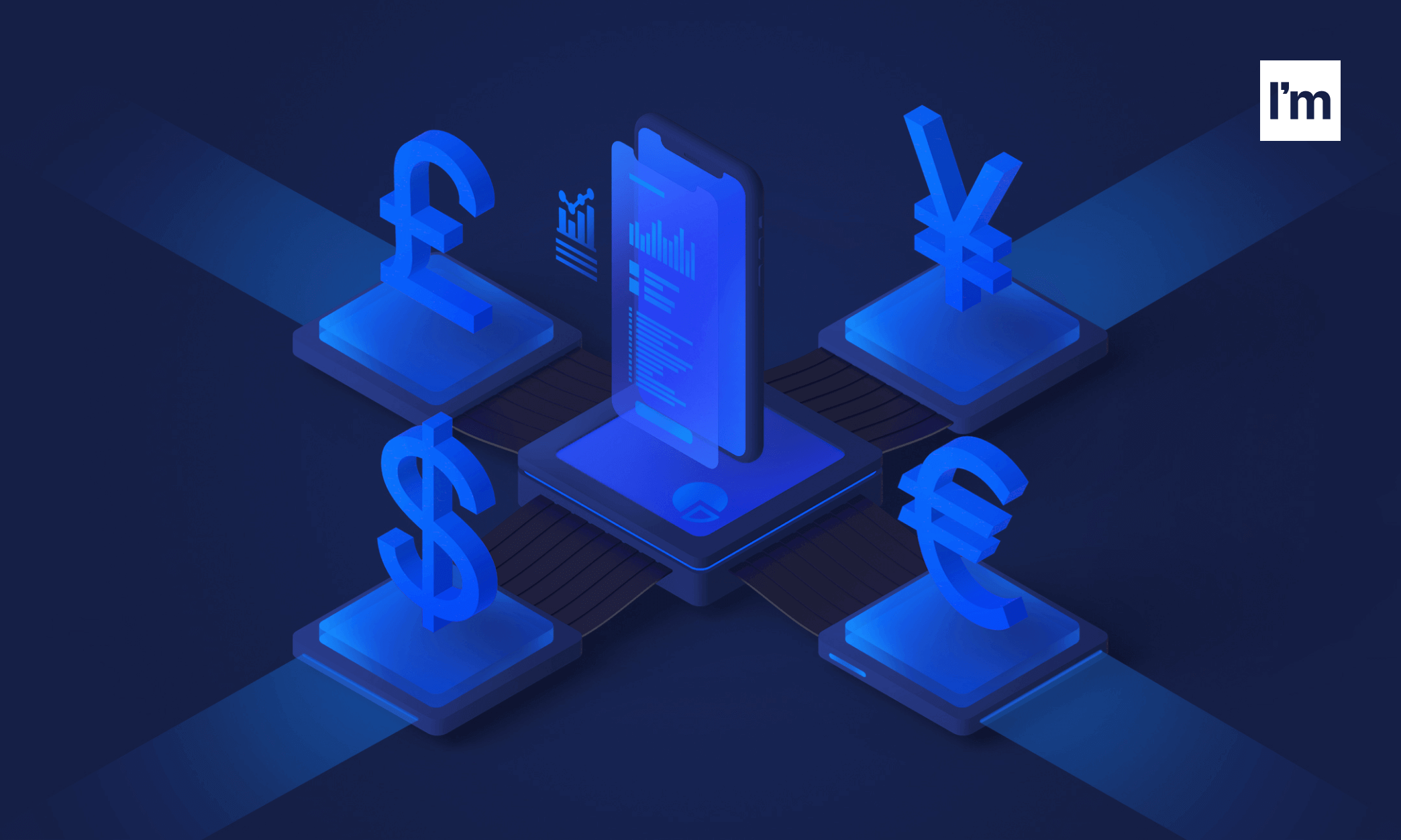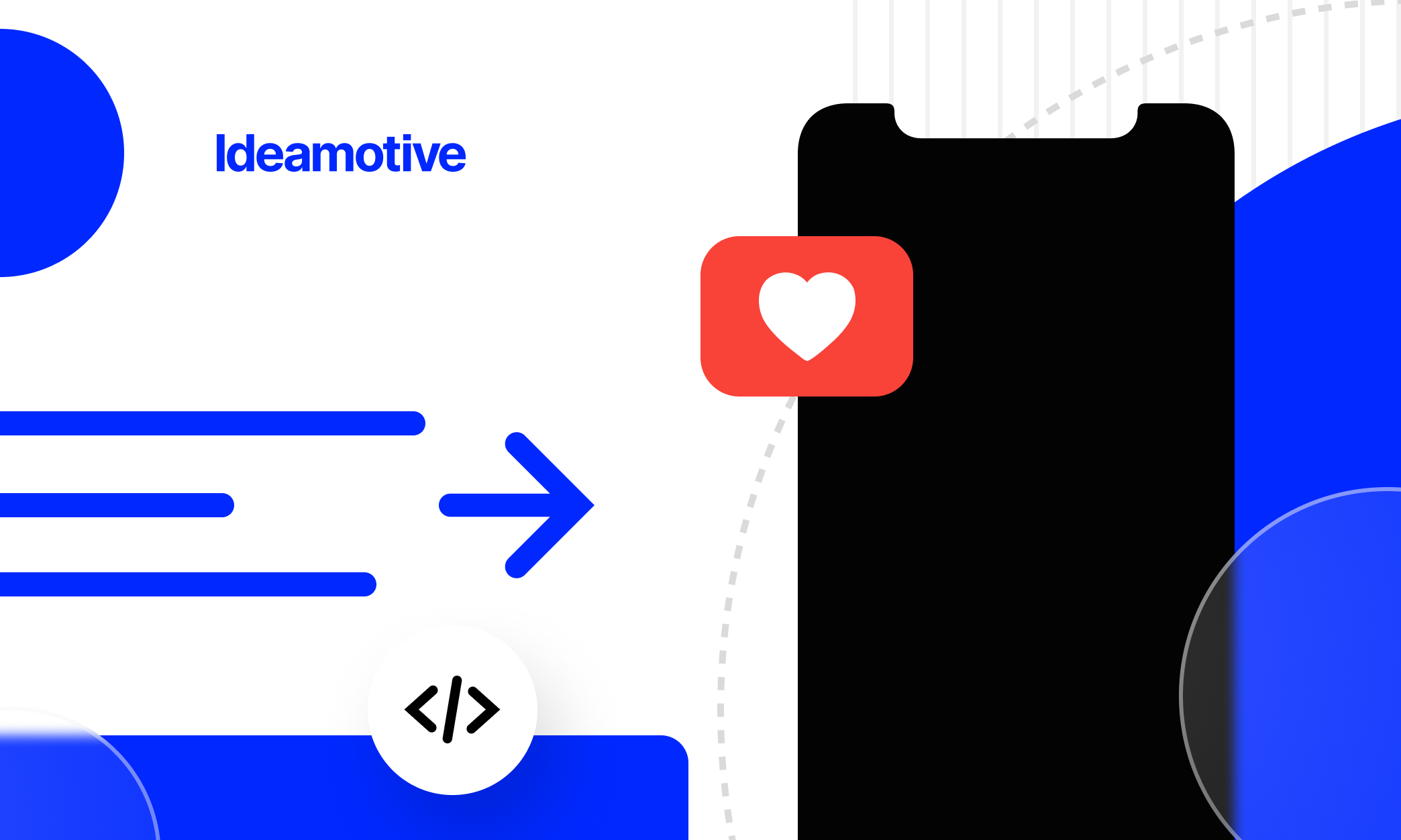How To Assess A Mobile App Development Cost? [Project Manager’s Guide]
Oct 28, 202016 min read

Jarosław Ziembiński
IT Project Manager at Ideamotive and agile advocate.

In 2021, the total number of global mobile app downloads amounted to 260 billion. In 2023, that number is estimated to reach a smashing 299 billion! Mobile apps have become central to the user experience on mobile devices like smartphones and tablets. Many entrepreneurs consider investing in mobile app development to realize their audacious business ideas. Companies turn to customer-facing apps and internal apps to address the growing demand for mobility and reach their audience on every channel.
If you’re also toying with the idea of developing a mobile app to create new revenue streams or unlock operational efficiencies, you’re probably wondering how much it costs and what factors impact the final price of mobile app development.
This guide takes you through the process of estimating mobile app development cost step by step, diving into the different variables that come into play when determining a budget for a mobile application.
Figuring Out Mobile App Cost: What Factors to Consider?
Developing a mobile app is an elaborate process that involves the contribution of several key roles. According to various sources, the costs of professional mobile app development can be anything between modest $5,000 to jaw-dropping $500,000:
- A 2017 Clutch survey indicated a median price of a mobile app at $171,450.
- According to Outsystems, 80% of mobile apps take +3 months to develop.
- 75% of enterprises surveyed by EMM spend over $250,000 on mobility solutions, while the remaining 25% — a whopping $1.5 million.
These numbers are humongous. However, they mostly apply to sophisticated proprietary enterprise-level mobile solutions that serve thousands of business end-users with intricate and robust features. Realistically, the cost of developing a simple app delivering a single functionality hovers between $15,000-$25,000, while medium-complexity apps typically fall within the range of $40,000-$100,000.
Still, that’s quite a gap! Let’s try to narrow it down a bit, and find out an approximate cost of your mobile app development.
Building a Mobile App — Cost Breakdown
In this article, we will delve deep into the few most fundamental cost drivers for mobile applications. Before we do it, here’s a helicopter view of all aspects that make up the price of mobile app development:
- App functionalities and purpose. Compare a single app with two-three screens, no integrations, basic backend and standard UI features, and a feature-packed business application with custom animations, sophisticated interaction patterns, AI integration, and user authentication. Data-driven or custom utility apps are much more expensive to build than basic functionality apps. They require advanced mobile app development skills and much more time, both of which entail higher costs.
- Development team. One mobile app developer is not sufficient to support a larger project. To pull off the development of a performant, user-oriented mobile application, you need a team that consists of a project manager, programmer, UX/UI designer, and QA specialist. Depending on your engagement model with these professionals (in-house, freelance, external), as well as their geographical location, the cost of their labor will vary dramatically.
- Target industry. Mobile technologies permeate all industries. Some of them, such as healthcare or accounting, impose strict security and regulatory requirements on software to protect users and their data better. Consequently, this enforces more advanced development and necessitates higher costs of implementation.
- Integration points. A significant part of the total cost associated with developing custom business apps comes from integration. If your app needs to speak to third-party solutions such as CRMs, social media platforms, project management tools, etc., this is going to affect the final pricing.
- Changes emerging during the production process. At the end of the day, the final cost of your app will be mostly related to the number of working hours spent by developers working on your future product. Keep in mind that every need of changing of adding something will generate additional costs.
- Support and maintenance. Every app requires post-deployment upgrades and enhancements to ensure seamless and bug-free operation. The extent of this support also determines the real cost of the app’s development.
Platform
In mobile development, you will be choosing between two different operating systems and consequently two different app stores: Android (Google Play) and iOS (App Store) Now, the question is: is it more expensive to develop an iOS or Android app? That issue is highly debated and generates many disagreements.
If we look at the cost of development, the cost per hour for hiring a developer to create an iOS and Android app is pretty similar (see the box below for average rates). However, note that iOS is a system that supports quite a narrow range of devices. When considering mobile applications, we’re pretty much talking about iPhones and iPads, with a possibility to convert application to macOS and support all kinds of Apple computers.
When it comes to an app for Google Play, the matter becomes quite complicated because there exists a much broader variety of Android devices with different screen sizes and produced by various manufacturers. That's why it takes much more time to develop an Android app. Some people say that the time frame might be even two or three times longer than one required for developing iOS apps. If you multiply that by the hourly rate of developers, it turns out that creating Android apps is indeed more expensive - you can use a simple app development cost calculator to check that. That's why many companies choose to develop iOS apps first and, once they validate their business idea, move to the Android market.
$$$ tip: There’s one important aspect of iOS/Android mobile app development that will help you save a few extra bucks. Namely, if you want your target solution needs to work on both platforms, cross-platform development with forefront technologies like React Native will save you coding time and effort, bringing the total cost down. This approach allows writing a single code base that will work for both Android and iOS app stores. It’s an interesting alternative to native development that saves a lot of time and money, speeding up the development process and allowing businesses to release their app quickly.
The Cost of Mobile App Development:
Your Software Team
Developing an app for iOS and Android takes about the same amount of time, from two to eight months, depending on the application. This period breaks down into:
- Research: 40-80 hours
- Prototyping: 40-120 hours
- Development: 80-300 hours
- Testing: 40-80 hours
When it comes to the cost of hiring mobile development teams to deliver the project within these timeframes, here’s what you should be expecting to pay, according to PayScale, Glassdoor, and other resources that track pay in the IT sector:
- In the US, the average hourly rate for mid-level mobile developers ranges between $70 and $100. Senior developers typically charge between $120-$200 per hour.
- In Central Europe, mid-level and senior mobile developers get an average of $35-$60 per hour.
- The average salary for a US iOS developer usually ranges between $106K-$125K per year, while the most experienced, high-end specialists can even get twice this amount.
- Android developers in the USA get $98K-$126K on average.
- In the UK, those rates are only slightly lower, at ca. $82K-$90K per year, and $93 per hour (median rate) for iOS developers. Android developers tend to earn slightly less.
Software development is a team effort. Let’s see how much you should expect to pay other professionals who are involved in the development of your solution:
- The annual salary of UX/UI architects in the USA ranges from $59K-$126K, on average, or $60 per hour. For freelancers, prepare to pay from $90 per hour up to $150 for high-end services. In countries like Poland, the Czech Republic, Latvia, or Bulgaria, those specialists earn around $30K per year.
- Mobile testers in the USA make $60K-$70K per year on average, with high-end testers earning up to $100K. To hire a European QA specialist, you need to pay about half of this rate.
- The average pay for software project managers in the USA is $125K per year. In the UK, the average salary on this position is much lower, at $62-70K. Software project managers in Central Europe earn from $35-50K per year, on average.
Features
The next vital factor to include in your calculation is the features and functionalities you plan for your application to have. In general, mobile applications can take advantage of many different functionalities that are built into smartphones, such as Bluetooth, camera, GPS, NFC, IoT, or even fingerprint reader. While some of them are easy to implement thanks to the existing tools and libraries that help developers avoid creating everything from scratch, others may take days or weeks to build.
To refine the calculation for your app’s budget, list all the functions that you would like to see and then remove those that aren’t critical for the first version of your app. This approach is called MVP (Minimum Viable Product) development, where you start with a minimum set of features that form the core of your application and leave the extra functions to be added later on as an update. This way, you will also be able to create a more realistic estimation and check how much you can afford right from the start.
$$$ tip: If you plan to create an MVP for your app, keep in mind the long-term goals that you want your app to achieve. At the MVP stage, that consideration is critical, so ask yourself questions like: Am I developing a prototype that will most likely be rewritten later? Will this app be the core of my startup? It’s essential that you have a clear idea about all these factors before setting out to cost estimation. And if you are confused about MVP development, consult us; we’ll be happy to share our knowledge and experiences.
MVP or a Full-blown Product?
Often, you don’t need a fully-fledged mobile app with all bells and whistles to get in front of your customers or investors. Premature scaling accounts for 70% of all startup failures, so instead of planning for a comprehensive feature-packed app, think about spinning out a Minimum Viable Product first.
By building an MVP, you can test your idea, get a chance to attract investors to cover the cost of the “actual” development, and gain precious feedback from beta users that will save you a whole lot of time (and money) on further research and UI work. A time required to build an MVP is usually an equivalent of 300-320 work hours distributed among the entire mobile app development team or done by a single developer, depending on the delivery schedule and project's complexity.
Your app’s purpose
You can equip your app with many different features, but remember that their type and number will directly impact the technical complexity of your project – and therefore the final app development cost. Here are some of the most common mobile application features with preliminary estimations to give you an idea which ones may turn out to be more expensive than others.
Please note, that the cost estimations below are just... estimations :) Usually, the price starts with the bottom value and can exceed the upper value. Again, it all depends on the app complexity level and there are various factors that can contribute to the final cost, such as processes within company, visual side of the project or custom elements or features that needs to be developed separately
In-app purchases
In-app purchases are one of the most common ways application publishers monetize their mobile apps. They allow you to sell various items ranging from virtual goods and premium content to extra functionalities and subscriptions. You can do that directly inside your application.
In general, in-app purchases add technical complexity to a project, and you can expect them to drive up your development costs (by $1,500-$3,000 on average). However, they offer a very attractive monetization model for mobile applications. That’s why it’s a good idea to weigh the pros and cons of including in-app purchases early on when defining your app development cost breakdown.
Third-party integrations
Another significant factor that impacts the app development cost is the integration of third-party frameworks, libraries, and services. By doing that, developers can get some functionalities up and running faster and at a much lower cost than developing a custom solution from scratch. Here are some examples of labor-intensive and costly integrations that may radically increase the total sum of your mobile app development:
Geolocation
Geolocation uses the phone’s GPS and real-time permissions to identify the geographical coordinates of the device and track the user’s whereabouts. Though it’s a must-have for commercial apps, geolocation is a sophisticated feature that requires at least 50 hours of development, i.e., $2,500-$5,000 extra on the final bill.
Payments integration
This feature is crucial if you want to sell your products or services via the mobile app. The scope of work is determined by several factors, such as platform type, payments processing type, number of integrations, level of payment protection, etc. Overall, expect to pay at least $2,500-$5,000 to add this feature to your app.
Social login and integration
Social logins remove friction from the login and registration processes, increasing user engagement, driving more subscriptions, and enhancing revenue from apps. With all the libraries available, social login integration is rather simple; the cost of implementation usually doesn’t go over $1,000.
AI integration
Powering your mobile app with Artificial Intelligence capabilities takes it to an entirely new level. Would you like to help your customers resolve their issues quickly with a chatbot? Are you looking to enhance the user experience through voice recognition? Maybe you need to boost your teams’ productivity and support their day-to-day operations with auto-generated email replies or in-depth data analytics? AI offers immense potential for mobile and can solve a myriad of business challenges for streamlined communication, faster response, and leaner processes. However, because of the endless applications of machine intelligence in mobile development, it’s not possible to scope the cost range without knowing the exact requirements. (If you would like to evaluate your idea, drop us a note, and we will estimate the cost of AI implementation in your app.)
Using ready-made solutions to implement anything from payment features and geolocation to real-time chats and social media sharing functions is a smart move. When preparing your mobile app cost estimation, take the presence or absence of third-party integrations into account.
Custom design
An app’s design matters just as much as its functionalities. Design can make or break an app, especially if it’s an MVP that doesn’t include many features. Even if your app can’t do many things, it should do what it was created for at top performance – combined with an optimal user interface. That’s why it’s a good idea to make your app stock look attractive with a custom design. However, the customized user interface will come at a cost. That’s why it’s yet another thing you need to weigh in your initial estimations and decide whether it’s worth the price.
Things That May Slow Down Your Mobile App Development (and Impact the Cost)
Here are some things that can put a damper on the development of your mobile app, leading to delays, and mounting costs:
- Inexperienced developers: The lack of your team’s experience in the creation of mobile business applications can result in costly errors, project setbacks, and missed opportunities, which are deleterious to your business. To ensure your project runs smoothly, as planned, and within budget, hire expert software teams that have a proven track record of designing and developing robust mobile apps for your niche.
- Outdated tech stack: Changes in mobile development happen fast. Relying on legacy tools may seem like a budget option, but it often involves costly app maintenance, unstable software, and compatibility issues.
- Complex technologies: On the other hand, if you want to pack your app with cutting-edge features such as AR & VR integration, Artificial Intelligence components, or IoT support, be aware that they take quite some time to implement, which drives the cost of your solution higher.
- Last-minute changes: Agile project management approach thrives on the assumption that change will occur throughout every software development process. However, all fundamental mid-project changes (e.g., core functionalities, design approach, target users) will entail cost increase.
Who will create your app?
Another significant factor you need to count into your estimation is who will create your app. At this point, you can choose between several available options: leveraging in-house developers, partnering with offshore IT companies, hiring freelance developers, or working with an agile software development agency. Below are the pros and cons of each strategy to help you understand which one will work to your advantage and match your budget.
In-house team
One strategy for realizing your idea for a mobile app is hiring in-house developers, designers, and product managers who will help you build it. It might be surprising that you need all these people and not just a team of developers. But in fact, mobile app development is complex, and quality apps require fulfilling different roles, not just software engineering. Usually, you also need someone to coordinate the many different tasks that are part of this process. And to ensure your solution works as desired, QA’s assistance is indispensable.
Here are some key aspects of in-house software development, which have a bearing on the total cost of your project.
PROS:
- Cultural fit. The main benefit of in-house teams is that their members possess a good understanding of your business and feel accountable for the outcome of the project as it’s their ‘baby’. Their goals are aligned with your business objectives, which also helps drive their motivation.
- Face-to-face communication. Direct interaction and the possibility to quickly catch up with your team in a meeting room help avoid misunderstanding and make teamwork more efficient. However, this advantage only applies if your team works together in the same space.
CONS:
- High cost. Assembling an entire squad of in-house experts is by far the most expensive option. Apart from the salaries that you need to pay each month, regardless of the scope of work, the overall expenses stretch over rent, taxes, software, hardware, training, benefits, and more costs that you save with other models.
- Long recruitment. With in-house teams, you’re in charge of hiring the best people for your project, which adds time, cost, and considerable effort to the process. You may also struggle with finding people that meet your needs on time, before the planned project kick-off.
- A small pool of tech talent. As the global competition on the IT market is soaring, the pool of talent for grabs is drying up. You may be spending weeks or months searching for the right people to realize a relatively short mobile development project and still fail to find them.
- Poor choice for MVP development. MVP development only makes sense when it’s fast and lean. You build it to test your idea, challenge assumptions, and validate the proposed product. Because of the exorbitant cost and time that in-house development entails, when building an MVP, you’ll be definitely better off with other options.
Individual freelancers
Another popular option for developing mobile apps is partnering with freelancers. You can find them on many online platforms, like Upwork, Freelancer, or Truelancer. But should you?
PROS:
- Moderate cost. That is when you compare it to building your own team. By hiring freelancers, you may expect to save up to 30%-50% of the budget you would have to spend on engaging your own employees.
- Flexibility. Hiring a freelancer is usually quick and rather painless. You go to a freelance platform, define your expectations and budget, and browse through the available profiles. Plus, you can usually terminate the service when you think suitable or if the quality of work isn’t up to par.
- Control. With freelancers, you’re the boss. Leveraging modern communication and project management platforms, you can easily monitor the progress of their work and impact the project execution at each stage. And the fact that you can directly speak to the people who work on your app gives you transparency and immediacy.
CONS:
- Narrow abilities. While some freelancers possess a variety of skills, they won’t be able to tackle all tasks on their own. They might be self-sufficient in software development but know next to nothing when it comes to business research or UX design. Therefore, you may need to take charge of some management activities and communication processes. That makes hiring a freelancer unsuitable for mid-size and larger projects that require a diverse set of skills to deliver.
- Unpredictable quality of work. Finding top-of-the-line developers will be challenging if the platforms that you are planning to use don’t have reliable pre-selection procedures in place to filter out low-quality suppliers. You won’t be able to easily verify the level of technical expertise freelancers possess or their ability to coordinate projects and communicate with customers. All in all, hiring freelancers from uncurated online job boards is always a bit of a gamble.
- No access to tools. Be also mindful of the fact that freelancers may not always have access to business tools that you use for project tracking and collaboration. In that case, you either have to supply them, which will impact the costs, or risk project inconsistencies and breakdowns in communication.
Offshore mobile development teams
Another solution is to seek outsourcing support from offshore IT companies that supply software development support in various engagement models. These firms provide teams of engineers, testers, and project managers who have tech skills to build software products.
PROS:
- Fast kick-off. Companies providing their services in this model can quickly supply the relevant team to move on with your project, as they have thousands of available resources. For the same reason, they are able to quickly scale their teams, as needed. If you are in a hurry - this is your best pick.
- Low cost. Very often, this is your cheapest option, especially in the fixed price model. Countries such as Poland or Romania are famous for their skilled tech talents at moderate prices. While considering this region you are fishing for world-class developers for half of the price.
- Skillset tailored to your business. Whether you are looking for a single UX expert to create spellbinding customer interactions for your mobile app or an entire team of mobile development adepts to research, design, develop, market, and release your mobile product, those agencies offer a vast pool of versatile talent to fill in your exact requirements. And if you are overwhelmed with the options, it is always good to limit your search to a certain niche or geography. For example, software developers from the CEE region have the opinion of the best in the world, while being more cost-effective than experts in the US or UK.
- High quality of the talent. Offshore development team providers always have some sort of screening process in place to ensure the quality of their
CONS:
- Possible communication issues. Sometimes the huge size of IT outsourcing corporations and the involvement of contracted workers dispersed in remote geographical areas hinder the project agility and slow down the progress of work. To avoid that you may consider teaming up with a smaller offshore software team provider to ensure flawless communication.
- Time-zones issues. This does not always happen and is not always an issue. But in specific cases, such as offshoring a development team from New York to India, the time difference is 10 hours. Virtually it means that when you start working, your development partner just finished, and all the feedback and comments will have to wait till the next day.
Classic software development agencies
Software development agencies support your teams with full-stack software development expertise and innovation, helping you supplement mission-critical skills and resources to implement your vision. They usually attract dedicated and skilled developers and have their processes in order.
PROS:
- Access to expert skills. Agile software agencies stand out by offering supreme quality of services, working with vetted digital experts whose talents and abilities are carefully examined. They also keep up to date with the latest advances in software development, engineering, and emerging tech, paying great attention to personal growth and using hackathons and meetups to power innovation.
- Full control over scope and budget. These agencies give you the same agility and control over your project as freelancers but with the added value of providing verified, battle-tested skills, from UX/UI design, through software engineering, to marketing your mobile app.
- Continuity of work. Your own employees take annual leaves. Freelancers can get sick. But when you engage with an agile agency, it takes care of providing a substitute for their specialists in case they become unavailable. This gives you the confidence that your mobile app will be ready on time and fits within the assumed budget.
- All tools included. When you hire agile agencies, you don’t need to be concerned with ensuring access to the required development and project management platforms. All is taken care of by the agencies that furnish their dedicated experts with the required toolkit. This helps you save thousands of dollars each month.
CONS:
- A higher investment. There’s no denying that hiring high-quality mobile development experts can be costly. These are masters of their trade who combine years of software development experience with business acumen. Nevertheless, although the total project costs of cooperation with these agencies might be higher than, e.g., working with freelancers, what you get in return is supreme quality and an app that works exactly to your specification.
- Limited talent pool. Usually, traditional software development agencies are relying mostly on their in-house employees. That means that the best possible option is not always available for you - the most talented Product Team may already be working on other projects.
- Limited technology pool. With a single agency, you are also often limited to mobile development technologies they are offering. In a result, Clients are not offered the best technology possible, but only the best technology available.
- Low probability of industry-match. The number of niches existing in today's mobile market is enormous. The chance that the agency you have picked has worked on a similar project like yours is usually quite low.
All of the hiring models above have some pros and cons. That's why in Ideamotive we believe you should not limit yourself to one hiring type and propose a hybrid hiring model.
We run a vast network of software talents which includes on-site developers, off-site contractors, and various software houses from the region.
As a result, we can quickly provide individual team extension or a whole development team, matched with the Client's industry, technology, and company culture.
We can also deliver product-matched software consultants for the pre-development phase and non-technical talents such as Project Managers or Scrum Masters, who will ensure the flawless delivery of the product. All on one invoice.
(If you want to learn more about our Talent Network and our process? Feel free to reach out!)
Key takeaway
As you can see, figuring out the cost of mobile app development is easier said than done. However, the above key factors should help you create a more accurate estimate that will allow you to develop a realistic budget for your mobile app.
And if you have any questions about estimating mobile app development costs, reach out to us, and we will get them answered.

Jarosław is an IT Project Manager at Ideamotive. Agile enthusiast with master experience on working with technical teams.
View all author postsDigital Marketplace Development Guide
How To Start Online Marketplace Business?
Read now
Trending articles
What Are The Best Frontend Frameworks To Use In 2023?
Dawid Karczewski 16 min read
21 Dazzling Examples of Mobile App UI Design to Inspire You in 2023
Michał Pruciak 7 min read
MedTech vs HealthTech vs BioTech: What Are The Differences?
Michał Pruciak 7 min read
Best React Native Boilerplates to Use In 2023
Michał Pruciak 6 min read
Python Mobile Development: When And Why to Build Your App With Python?
Dawid Karczewski 10 min read
We believe in the power of sharing knowledge and expertise:
Looking for a specific type of software development service?
Take your business to the hypergrowth phase.
Work with Mobile App experts from Ideamotive's talent network.

Business registry data:
Zlota 61/101, 00-819 Warsaw
Poland, European UnionKRS: 0000529079
hello@ideamotive.co
Company
Services
Most desired experts
Resources
Rated 4.8 / 5.0 by clients from various industries and locations.



